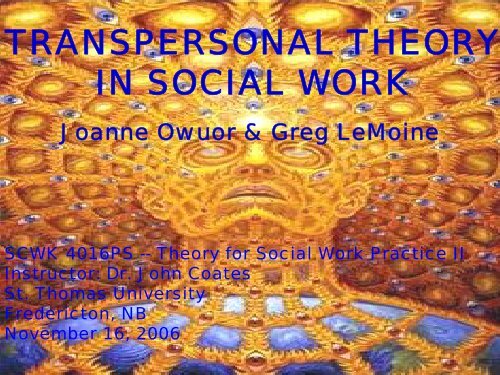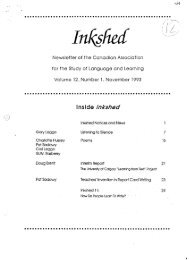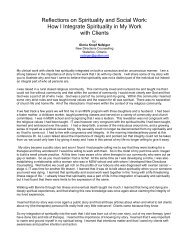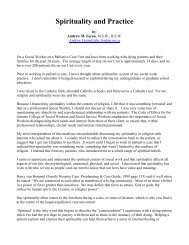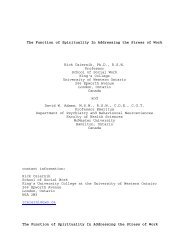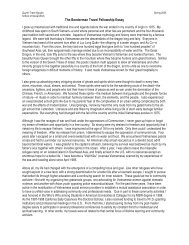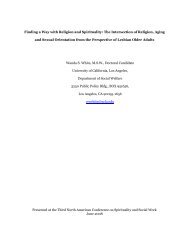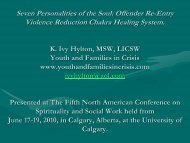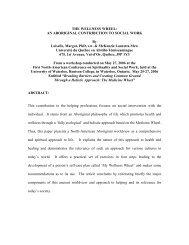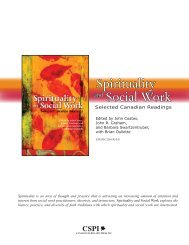transpersonal theory in social work - St. Thomas University
transpersonal theory in social work - St. Thomas University
transpersonal theory in social work - St. Thomas University
You also want an ePaper? Increase the reach of your titles
YUMPU automatically turns print PDFs into web optimized ePapers that Google loves.
TRANSPERSONAL THEORY<br />
IN SOCIAL WORK<br />
Joanne Owuor & Greg LeMo<strong>in</strong>e<br />
SCWK 4016PS -- Theory for Social Work Practice II<br />
Instructor: Dr. John Coates<br />
<strong>St</strong>. <strong>Thomas</strong> <strong>University</strong><br />
Fredericton, NB<br />
November 16, 2006
To my amazement . . . the imagery of schizophrenic fantasy<br />
perfectly matches that of the mythological Hero’s Journey.<br />
- Joseph Campbell<br />
In <strong>in</strong>sanity we do not discover anyth<strong>in</strong>g new and unknown; we<br />
are look<strong>in</strong>g at the foundations of our own be<strong>in</strong>g, the matrix of<br />
those vital problems on which we are all engaged.<br />
- Carl Jung<br />
Source: www.worldofquotes.com
If the doors of perception were cleansed, every th<strong>in</strong>g would<br />
appear to man [sic] as it is, <strong>in</strong>f<strong>in</strong>ite.<br />
William Blake<br />
Your experience of life can teach you everyth<strong>in</strong>g you need to<br />
know if you are but awake enough to receive the message.<br />
Hendricks & We<strong>in</strong>hold (1982)<br />
Source: www.worldofquotes.com
AGENDA<br />
‣ Influences<br />
‣ Transpersonal Theories and<br />
Spokespeople<br />
‣ Nature of the Problem<br />
‣ Major Assumptions<br />
‣ Conditions for Change<br />
‣ Cause of Change<br />
‣ Goals of Intervention<br />
‣ Methods & Skills<br />
‣ Human Energy System (Chakras)<br />
‣ Role of Social Worker<br />
‣ Case <strong>St</strong>udy<br />
‣ <strong>St</strong>rengths and Limitations<br />
‣ L<strong>in</strong>ks to <strong>St</strong>ructural Social Work<br />
Practice<br />
‣ Summary<br />
‣ Guest Speaker
CASE STUDY
WHAT MAKES<br />
A<br />
TRANSPERSONAL<br />
SOCIAL WORKER?<br />
Source: “Self-<strong>in</strong>ventory on attitudes of <strong>transpersonal</strong> counselors and therapists,” Hendricks & We<strong>in</strong>hold (1982)
INFLUENCES
‣Diverse worldviews (e.g., Halifax—<br />
shamanism)<br />
‣Transpersonal psychoanalytic<br />
approaches (e.g., Engler, Epste<strong>in</strong>,<br />
Suler)<br />
‣Body-centred <strong>transpersonal</strong><br />
approaches (e.g., Hakomi, Pierrakos’<br />
Core Energetics, <strong>work</strong> of Wilhelm<br />
Reich, rebirth<strong>in</strong>g)<br />
Source: Robb<strong>in</strong>s, Chatterjee & Canda (1998, 2006); Cowley (1993, 1996)
Existential Theory<br />
‣ Perspectives with<strong>in</strong> existential <strong>theory</strong><br />
which emphasize that authentic mean<strong>in</strong>g<br />
comes from personal experiences of a<br />
<strong>transpersonal</strong> or sacred nature<br />
‣ focus on mean<strong>in</strong>g-mak<strong>in</strong>g<br />
‣ Donald Krill (Christian/Zen-<strong>in</strong>fluenced<br />
<strong>social</strong> <strong>work</strong>er)<br />
Paul Tillich Mart<strong>in</strong> Buber Viktor Frankl<br />
Source: Robb<strong>in</strong>s, Chatterjee & Canda (1998, 2006); Cowley (1993, 1996)
Diverse Religious Practices<br />
Source: Robb<strong>in</strong>s, Chatterjee & Canda (1998, 2006); Cowley (1993, 1996)
Transpersonal<br />
Psychodynamic Theories<br />
Carl Jung<br />
‣ Saw psychotherapy as heal<strong>in</strong>g for the soul<br />
‣ Preconscious – stores easily retrievable<br />
memories; Personal Unconscious –<br />
repressed and long forgotten memories;<br />
Collective Unconscious – universal<br />
potentials for mean<strong>in</strong>g which he termed<br />
“archetypes”<br />
‣ Synchronicity – acausal relationship<br />
between two events<br />
Roberto Assagioli<br />
‣ Model termed<br />
Psychosynthesis<br />
‣ Involves disidentification with<br />
the subpersonalities of the<br />
lower unconscious and mak<strong>in</strong>g<br />
contact with the higher<br />
conscious (Transpersonal Self)<br />
‣ Process uses guided imagery<br />
and contact with the <strong>in</strong>ner child<br />
Source: Robb<strong>in</strong>s, Chatterjee & Canda (1998, 2006); Cowley (1993, 1996); Rowan (1993)
Humanistic Psychology<br />
Theory of Self-Actualization and Self-Transcendence<br />
‣ Based on the notion of liv<strong>in</strong>g with dignity and worth<br />
rather than liv<strong>in</strong>g based on acquisitiveness/materialism<br />
‣ Unitive Consciousness – experience of self <strong>in</strong><br />
communion with others<br />
‣ co<strong>in</strong>ed terms:<br />
Peak Experience – <strong>in</strong>dividual’s ego boundary loosens or<br />
dissolves altogether<br />
Nadir Experience - <strong>in</strong>tense encounters with death,<br />
medical emergencies, and psychological traumas<br />
Plateau Experience – state of pure enjoyment/happ<strong>in</strong>ess<br />
Abraham Maslow<br />
Source: Robb<strong>in</strong>s, Chatterjee & Canda (1998, 2006); Cowley (1993, 1996); Rowan (1993)
STUDIES OF ALTERNATIVE<br />
STATES OF CONSCIOUSNESS<br />
Holotropic Model<br />
‣ Based on studies on the effects of LSD use<br />
‣ Individuals must <strong>work</strong> through the realm of the<br />
sensory barrier/personal unconscious, and the<br />
per<strong>in</strong>atal/birth-related realm, <strong>in</strong>to the<br />
<strong>transpersonal</strong> realm <strong>in</strong> order to <strong>work</strong> through the<br />
<strong>in</strong>dividual’s psychopathology<br />
‣ Through the use of holotropic<br />
breath<strong>work</strong> (which mirrors the<br />
effects of LSD), oxygen <strong>in</strong>creases<br />
the energy <strong>in</strong> the person’s system<br />
‣ The <strong>in</strong>creased energy activates<br />
the parts of the psyche that need<br />
heal<strong>in</strong>g<br />
<strong>St</strong>anislav Grof<br />
Source: Robb<strong>in</strong>s, Chatterjee & Canda (1998, 2006); Cowley (1993, 1996); Rowan (1993)
Spectrum Model/<br />
Integral Theory<br />
Proposes three basic stages of development:<br />
‣ Prepersonal – developmental failures dur<strong>in</strong>g<br />
these levels manifest as psychosis, borderl<strong>in</strong>e<br />
personality disorder, and neurosis<br />
‣ Personal – developmental failures dur<strong>in</strong>g these<br />
levels result <strong>in</strong> identity neurosis, existential<br />
pathology, and cognitive-script<br />
pathology<br />
‣ Transpersonal –<br />
developmental failures dur<strong>in</strong>g<br />
these levels result <strong>in</strong> psychic<br />
disorders (e.g., dark night of<br />
the soul), subtle disorders,<br />
and causal disorders<br />
Ken Wilber<br />
Source: Robb<strong>in</strong>s, Chatterjee & Canda (1998, 2006); Cowley (1993, 1996)
Clairvoyance Unitive Experience<br />
Unorthodox/Spiritual heal<strong>in</strong>g<br />
EXAMPLES<br />
OF<br />
Out-of-Body Experience<br />
Num<strong>in</strong>ous Dream<br />
Ghost Encounter<br />
Déjà-Vu<br />
Gaia or Earth Experience<br />
Clairsentience<br />
Near-Death ExperienceAngel Encounter<br />
Deathbed Experience<br />
TRANSPERSONAL<br />
Kundal<strong>in</strong>i<br />
UFO Encounter<br />
Telepathy<br />
EXPERIENCES<br />
Tears of “wonder joy”<br />
Source: Palmer & Braud (2002)
Nature of the Problem<br />
‣ Disconnection from the sacred nature of<br />
life (oneness, nondualism,<br />
<strong>in</strong>terconnectedness), as well as deeper<br />
sources of mean<strong>in</strong>g and fulfillment<br />
‣ Attachment and identification with<br />
personality (which is conditional) rather than<br />
with a <strong>transpersonal</strong> reality (which is<br />
unconditional)<br />
‣ Responsibility for change lies with the<br />
client, but the larger goal is for societal<br />
transcendence of ego attachment<br />
‣ Contra<strong>in</strong>dications for <strong>transpersonal</strong> <strong>social</strong><br />
<strong>work</strong>: unwill<strong>in</strong>g clients, clients <strong>in</strong> the<br />
preegoic phase<br />
Source: Robb<strong>in</strong>s, Chatterjee & Canda (1998, 2006); Hendricks & We<strong>in</strong>hold (1982)
MAJOR<br />
ASSUMPTIONS
‣Our essential nature is spiritual<br />
- the spiritual source supports<br />
and upholds the psychological<br />
structures of the self; see the light<br />
<strong>in</strong> self and others<br />
‣Consciousness is multidimensional<br />
- normal, ord<strong>in</strong>ary consciousness<br />
is very limited and restricted—<br />
other approaches adopt an<br />
impoverished view of<br />
consciousness<br />
Source: Hendricks & We<strong>in</strong>hold (1982); Rowan (1993); Cowley (1993); Canda & Furman (1999)
‣ Spiritual seek<strong>in</strong>g is a valid and healthy<br />
human urge<br />
- quest for spiritual union and<br />
wholeness results <strong>in</strong> a deepen<strong>in</strong>g<br />
<strong>in</strong>dividual, <strong>social</strong>, and transcendent<br />
awareness<br />
- client may need to embark on a<br />
journey of descent (e.g., mythic Hero’s<br />
Journey)<br />
‣ Connect<strong>in</strong>g with a deeper source of<br />
wisdom/guidance with<strong>in</strong> is part of<br />
human growth<br />
- access<strong>in</strong>g <strong>in</strong>ner wisdom; authentic<br />
self versus defensive false self<br />
Source: Hendricks & We<strong>in</strong>hold (1982); Rowan (1993); Cowley (1993); Canda & Furman (1999)
‣It is healthy for <strong>in</strong>dividuals to<br />
attempt to unite with the div<strong>in</strong>e<br />
- this creates optimal conditions<br />
for psychological <strong>in</strong>tegration;<br />
there are many paths to unity,<br />
<strong>in</strong>clud<strong>in</strong>g atheism<br />
‣Altered states of consciousness<br />
are a mechanism for access<strong>in</strong>g<br />
<strong>transpersonal</strong> experiences and<br />
can aid heal<strong>in</strong>g/growth<br />
Source: Hendricks & We<strong>in</strong>hold (1982); Rowan (1993); Cowley (1993); Canda & Furman (1999)
‣Our life experiences and actions<br />
are mean<strong>in</strong>gful<br />
- the wounds and tragedies of life<br />
provide the impetus to make the<br />
<strong>in</strong>ward journey<br />
- life seen as a series of<br />
opportunities rather than<br />
obstacles<br />
- human need to cont<strong>in</strong>ually<br />
discover deeper mean<strong>in</strong>g, and to<br />
cont<strong>in</strong>ually construct and <strong>in</strong>terpret<br />
the mean<strong>in</strong>g we have made<br />
Source: Hendricks & We<strong>in</strong>hold (1982); Rowan (1993); Cowley (1993); Canda & Furman (1999)
‣Awaken<strong>in</strong>g comes through selfobservation<br />
and dispell<strong>in</strong>g<br />
knowledge/<strong>social</strong> condition<strong>in</strong>g<br />
‣Accept<strong>in</strong>g and lov<strong>in</strong>g self and<br />
others leads to transformation;<br />
otherwise endless energy is<br />
expended <strong>in</strong> resistance<br />
- the way out is through<br />
Source: Hendricks & We<strong>in</strong>hold (1982); Rowan (1993); Cowley (1993); Canda & Furman (1999)
‣Context shapes how the person/<br />
client is viewed<br />
- rather than see<strong>in</strong>g the client as<br />
“other”, client and <strong>social</strong> <strong>work</strong>er<br />
are viewed as evolv<strong>in</strong>g be<strong>in</strong>gs<br />
and fellow seekers<br />
- results <strong>in</strong> compassion towards<br />
the client<br />
- <strong>social</strong> <strong>work</strong>er required to move<br />
towards heart-centred practice<br />
while still ma<strong>in</strong>ta<strong>in</strong><strong>in</strong>g boundaries<br />
Source: Hendricks & We<strong>in</strong>hold (1982); Rowan (1993); Cowley (1993); Canda & Furman (1999)
CONDITIONS<br />
FOR CHANGE
‣Mutuality/collaborative relationship<br />
between <strong>social</strong> <strong>work</strong>er and client<br />
‣Br<strong>in</strong>g client’s awareness to their<br />
level of consciousness and that of<br />
their support systems (e.g., family<br />
members)<br />
‣Allow client to talk through feel<strong>in</strong>gs<br />
‣Will<strong>in</strong>gness for <strong>social</strong> <strong>work</strong>er to<br />
explore and understand their own<br />
feel<strong>in</strong>gs (self-understand<strong>in</strong>g)<br />
Source: Hendricks & We<strong>in</strong>hold (1982); Rowan (1993); Cowley (1993); Canda & Furman (1999)
‣Will<strong>in</strong>gness of client to recognize<br />
manifestations of self <strong>in</strong> other<br />
people<br />
‣Will<strong>in</strong>gness to explore<br />
<strong>transpersonal</strong> experiences (e.g.,<br />
nadir, peak, plateau) <strong>in</strong>depth and<br />
to the limit<br />
Source: Hendricks & We<strong>in</strong>hold (1982); Rowan (1993); Cowley (1993); Canda & Furman (1999)
CAUSE OF<br />
CHANGE
‣Expanded awareness of <strong>in</strong>dividual<br />
which allows for fuller life<br />
experience<br />
‣Acceptance that life experiences<br />
which are typically viewed as be<strong>in</strong>g<br />
external to oneself are actually<br />
projections<br />
‣Reclaim<strong>in</strong>g these projections<br />
which may <strong>in</strong>volve learn<strong>in</strong>g new<br />
techniques<br />
Source: Hendricks & We<strong>in</strong>hold (1982); Rowan (1993); Cowley (1993); Canda & Furman (1999)
‣ Realization that there is absolutely no<br />
difference between what is experienced<br />
as with<strong>in</strong> and what is experienced as<br />
outside the self<br />
‣ Reclaim<strong>in</strong>g, voic<strong>in</strong>g, and embrac<strong>in</strong>g<br />
disowned experiences and shadow<br />
selves, and mak<strong>in</strong>g them part of<br />
personal understand<strong>in</strong>g<br />
‣ Determ<strong>in</strong>ation of level of consciousness<br />
of everyone <strong>in</strong> client’s support system<br />
(assessment)<br />
Source: Hendricks & We<strong>in</strong>hold (1982); Rowan (1993); Cowley (1993); Canda & Furman (1999)
GOALS OF<br />
INTERVENTION
‣Enable the client to ga<strong>in</strong> an<br />
expanded view and a deeper<br />
understand<strong>in</strong>g of self<br />
‣Assist client <strong>in</strong> ground<strong>in</strong>g their<br />
behaviour and experiences <strong>in</strong> a<br />
new context<br />
‣Assist client <strong>in</strong> understand<strong>in</strong>g their<br />
beliefs to identify whether their<br />
m<strong>in</strong>d is serv<strong>in</strong>g them or enslav<strong>in</strong>g<br />
them<br />
Source: Hendricks & We<strong>in</strong>hold (1982); Rowan (1993); Cowley (1993); Canda & Furman (1999)
‣Client to assume complete<br />
ownership for personal behaviour<br />
and responsibilities<br />
‣Work towards develop<strong>in</strong>g a<br />
deeper understand<strong>in</strong>g of identity<br />
and roles (masks), and self-image<br />
‣Learn to experience th<strong>in</strong>gs the<br />
way they are <strong>in</strong> the present (the<br />
“power of now”)<br />
‣Balanc<strong>in</strong>g personal energy<br />
system (chakras)<br />
Source: Hendricks & We<strong>in</strong>hold (1982); Rowan (1993); Cowley (1993); Canda & Furman (1999)
‣Help client recognize<br />
misperceptions and the negative,<br />
limited effects these are hav<strong>in</strong>g on<br />
them and their life<br />
‣Help client develop a more<br />
<strong>transpersonal</strong> view of themselves,<br />
other people, and the world<br />
(oneness)<br />
‣Help the client to learn to <strong>in</strong>tegrate<br />
this and become grounded<br />
Source: Hendricks & We<strong>in</strong>hold (1982); Rowan (1993); Cowley (1993); Canda & Furman (1999)
ROLE OF SOCIAL WORKER<br />
‣ Enabler<br />
- normalizes and contextualizes<br />
<strong>transpersonal</strong> experiences as<br />
opportunities for growth and<br />
development<br />
‣ Guide<br />
- <strong>social</strong> <strong>work</strong>er must be dedicated to a<br />
personal spiritual path and have direct<br />
<strong>transpersonal</strong> experiences<br />
- supports client through <strong>in</strong>tegration<br />
process
‣ Coach<br />
- assists client <strong>in</strong> learn<strong>in</strong>g to utilize<br />
expanded context <strong>in</strong> daily life<br />
- assists client <strong>in</strong> develop<strong>in</strong>g tools and<br />
learn<strong>in</strong>g skills to <strong>in</strong>corporate<br />
<strong>transpersonal</strong> experiences <strong>in</strong>to<br />
everyday life<br />
- prepar<strong>in</strong>g client for spiritual<br />
emergence (to avert emergencies)<br />
‣ Facilitator<br />
- assists <strong>in</strong> the process of mean<strong>in</strong>gmak<strong>in</strong>g<br />
and <strong>in</strong>tegration of<br />
<strong>transpersonal</strong> experiences<br />
Source: Hendricks & We<strong>in</strong>hold (1982); Rowan (1993); Cowley (1993); Canda & Furman (1999)
‣Advocate<br />
- <strong>work</strong><strong>in</strong>g to transcend modernity<br />
paradigm<br />
‣Other roles of the <strong>social</strong> <strong>work</strong>er:<br />
- performs assessment to<br />
determ<strong>in</strong>e development stage<br />
(preegoic versus transegoic)<br />
- develops resource base for<br />
referrals where <strong>social</strong> <strong>work</strong>er<br />
cannot provide tra<strong>in</strong><strong>in</strong>g<br />
- provides resources
CASE STUDY<br />
REDUX
CASE STUDY<br />
QUESTIONS<br />
1. How would you def<strong>in</strong>e the nature of the<br />
client’s crisis?<br />
2. What would you see as signs that the client<br />
might have reached a higher level of<br />
transcendence or self-actualization?<br />
3. As the <strong>social</strong> <strong>work</strong>er, what roles would you<br />
see for yourself <strong>in</strong> this situation?<br />
4. How would you facilitate the mean<strong>in</strong>gmak<strong>in</strong>g<br />
process and normalize the client’s<br />
experiences?<br />
5. What <strong>in</strong>terventions would you recommend<br />
to the client to assist him <strong>in</strong> <strong>in</strong>tegrat<strong>in</strong>g this<br />
experience <strong>in</strong>to his daily life?
METHODS &<br />
SKILLS
‣Attentive listen<strong>in</strong>g<br />
‣Empathy, validation, and<br />
affirmation<br />
‣Unconditional positive regard<br />
‣Open-m<strong>in</strong>dedness as well as a<br />
will<strong>in</strong>gness to experience and<br />
share all feel<strong>in</strong>gs, thoughts, ideas<br />
‣Exam<strong>in</strong><strong>in</strong>g client’s beliefs (“m<strong>in</strong>d<br />
scripts”)<br />
‣Challenge labell<strong>in</strong>g and scientific<br />
knowledge<br />
Source: Hendricks & We<strong>in</strong>hold (1982); Rowan (1993); Cowley (1993); Canda & Furman (1999)
SOME INTERVENTION<br />
TECHNIQUES<br />
‣Meditation<br />
‣Breath<strong>in</strong>g/Holotropic breath<strong>work</strong><br />
‣Bibliotherapy<br />
‣Yoga, tai chi<br />
‣Dance and movement<br />
‣Personalized ritual<br />
‣Hypnotism, guided imagery<br />
‣Chakra clear<strong>in</strong>g and balanc<strong>in</strong>g<br />
‣EFT (Emotional Freedom<br />
Technique)<br />
Source: Hendricks & We<strong>in</strong>hold (1982); Rowan (1993); Cowley (1993); Canda & Furman (1999)
‣ Relaxation tra<strong>in</strong><strong>in</strong>g<br />
‣ Dream <strong>in</strong>terpretation, archetypes<br />
‣ Center<strong>in</strong>g exercises<br />
‣ Shamanic journey<strong>in</strong>g<br />
‣ Bioenergetics<br />
‣ Journal <strong>work</strong><br />
‣ Develop<strong>in</strong>g personal mythology<br />
(overwrite dysfunctional ones)<br />
‣ Development of mental strategies to<br />
enable the <strong>in</strong>dividual to cope better<br />
with their feel<strong>in</strong>gs (e.g., fear, anger),<br />
relate to them, and accept them<br />
Source: Hendricks & We<strong>in</strong>hold (1982); Rowan (1993); Cowley (1993); Canda & Furman (1999)
Traditional neglect of <strong>transpersonal</strong><br />
aspects of assessment and<br />
<strong>in</strong>tervention have led to:<br />
‣ devastat<strong>in</strong>g misdiagnoses<br />
‣ not <strong>in</strong>frequent mistreatment<br />
‣ development of helper <strong>in</strong>sensitivity<br />
‣ an <strong>in</strong>creas<strong>in</strong>gly poor reputation<br />
amongst <strong>social</strong> <strong>work</strong>ers and other<br />
helpers<br />
‣ <strong>in</strong>adequate research and <strong>theory</strong><br />
‣ a limitation of helpers’ own personal<br />
development<br />
Source: Hendricks & We<strong>in</strong>hold (1982); Rowan (1993); Cowley (1993); Canda & Furman (1999); www.spiritualcompetency.com
Other theories’ views of<br />
<strong>transpersonal</strong> experience:<br />
‣ Spirit and soul is horseshit of the worst sort. Obviously<br />
there are no fairies, no Santa Clauses, no spirits. What<br />
there is, is human goals and purposes.... But a lot of<br />
transcendentalists are utter screwballs. The elegant<br />
therapeutic solution to emotional problems is quite<br />
unreligious.... The less religious they [patients] are, the<br />
more emotionally healthy they will tend to be. (Ellis --<br />
REBT)<br />
‣ A system of wishful illusions together with a disavowal<br />
of reality, such as we f<strong>in</strong>d nowhere else...but <strong>in</strong> a state<br />
of blissful halluc<strong>in</strong>atory confusion (Freud –<br />
psychoanalysis). He also saw the experience of<br />
mystics as an <strong>in</strong>fantile helplessness and a regression<br />
to primary narcissism.<br />
‣ [Religion] is an explanatory fiction, of a miracle-<strong>work</strong><strong>in</strong>g<br />
m<strong>in</strong>d...superstitious behavior perpetuated by an<br />
<strong>in</strong>termittent re<strong>in</strong>forcement schedule. (Sk<strong>in</strong>ner –<br />
behaviourism)<br />
Source: Ellis & Yeager (1989); www.spiritualcompetency.com
DSM-IV<br />
The <strong>in</strong>corporation of spiritual and religious<br />
problems <strong>in</strong>to the DSM-IV was <strong>in</strong>tended to:<br />
‣ <strong>in</strong>crease the accuracy of assessments when<br />
religious and spiritual issues are <strong>in</strong>volved<br />
‣ reduce the occurrence of iatrogenic<br />
(professionally-<strong>in</strong>duced) harm from<br />
misdiagnosis of religious and spiritual<br />
problems<br />
‣ improve treatment of and <strong>in</strong>terventions for<br />
such problems by stimulat<strong>in</strong>g cl<strong>in</strong>ical research<br />
‣ improve treatment of and <strong>in</strong>terventions for<br />
such problems by encourag<strong>in</strong>g tra<strong>in</strong><strong>in</strong>g<br />
centres to address religious and spiritual<br />
issues <strong>in</strong> their programmes<br />
Source: www.spiritualcompetency.com
‣Differential diagnosis<br />
- religious problem, spiritual<br />
problem (emergence versus<br />
emergency), psychotic episode<br />
‣Pre/trans fallacy<br />
- must take <strong>in</strong>to account the<br />
difference between preegoic and<br />
transegoic stages of development<br />
dur<strong>in</strong>g assessment to avoid<br />
<strong>in</strong>appropriate diagnosis<br />
‣Limitation of DSM-IV: V-codes<br />
Source: Canda & Furman (1999); www.spiritualcompetency.com
HUMAN ENERGY SYSTEM<br />
TRANSCENDENCE<br />
MIND; CLARITY<br />
WILL<br />
LOVE<br />
SELF<br />
POWER<br />
TRIBE<br />
Source: Myss (1996)
Chakra 1<br />
Chakra 2<br />
Chakra 3<br />
Chakra 4<br />
Chakra 5<br />
Chakra 6<br />
Chakra 7<br />
Safety <strong>in</strong> the physical world<br />
Power and control <strong>in</strong> the material world;<br />
money, sex, and control of other people<br />
Personal power, fear of <strong>in</strong>timidation and<br />
rejection, lack of self-esteem and survival<br />
<strong>in</strong>tuition<br />
Issues concern<strong>in</strong>g love, <strong>in</strong>clud<strong>in</strong>g<br />
creat<strong>in</strong>g from the heart, follow<strong>in</strong>g your<br />
heart’s desire, and love of other forms of<br />
life<br />
Development of will power and personal<br />
expression<br />
Use of knowledge, higher reason<strong>in</strong>g, and<br />
<strong>in</strong>tuitive skills.<br />
Acceptance of one’s life, capacity to<br />
fulfill one’s (higher) purpose and f<strong>in</strong>d<br />
mean<strong>in</strong>g <strong>in</strong> life<br />
Chakra Self Test (handout)<br />
Source: Myss (1996); Judith (2004)
Liv<strong>in</strong>g solely by the <strong>in</strong>fluence of the lower 3<br />
chakras results <strong>in</strong> th<strong>in</strong>gs like:<br />
‣act<strong>in</strong>g <strong>in</strong>appropriately <strong>in</strong> situations<br />
‣jump<strong>in</strong>g to conclusions<br />
‣second-guess<strong>in</strong>g others<br />
‣tak<strong>in</strong>g everyth<strong>in</strong>g personally<br />
‣mis<strong>in</strong>terpret<strong>in</strong>g casual k<strong>in</strong>dness for romantic<br />
‣affection<br />
ARCHETYPES<br />
‣Accord<strong>in</strong>g to Myss (2003), every <strong>in</strong>dividual<br />
has twelve archetypes which <strong>in</strong>fluence their<br />
development. These <strong>in</strong>clude the 4 survival<br />
archetypes:<br />
- Child, Victim, Prostitute, and Saboteur<br />
‣Each archetype can operate <strong>in</strong> the light or<br />
<strong>in</strong> the shadow.<br />
Source: Myss (1996, 2003)
STRENGTHS<br />
&<br />
LIMITATIONS
STRENGTHS<br />
‣ Mutuality between client and <strong>social</strong><br />
<strong>work</strong>er—they are engaged <strong>in</strong> mutual<br />
growth and development as well as<br />
learn<strong>in</strong>g from each other<br />
- common growth-oriented <strong>in</strong>tention for<br />
sessions allows for closer <strong>in</strong>teraction<br />
between client and <strong>social</strong> <strong>work</strong>er (less<br />
distance between them)<br />
- <strong>social</strong> <strong>work</strong>er is not seen to be the<br />
‘expert’ and plays the role of guide and<br />
facilitator
‣ Validates and normalizes client<br />
knowledge and experience, and offers<br />
tools/skills for <strong>in</strong>tegration of these<br />
experiences<br />
‣ 24-hour therapy—relevant to all<br />
experiences <strong>in</strong> life<br />
‣ Recognizes there are many paths to<br />
awareness/consciousness without<br />
show<strong>in</strong>g preference for one over<br />
another<br />
‣ Rem<strong>in</strong>ds <strong>in</strong>dividuals to accept and<br />
listen to their <strong>in</strong>ner voices,<br />
precognitions, and <strong>in</strong>tuition
‣Recognizes that everyone and<br />
everyth<strong>in</strong>g can teach/guide you<br />
along your journey<br />
‣Peace-oriented teach<strong>in</strong>gs<br />
(compassion for all)<br />
‣More holistic than most other<br />
theories—<strong>in</strong>corporates m<strong>in</strong>d-bodyspirit<br />
approaches to human growth<br />
and development<br />
‣New literature support<strong>in</strong>g use <strong>in</strong><br />
mezzo- (France, 2002) and<br />
macro-level practice
‣Postmodern <strong>in</strong> nature—questions<br />
scientism, materialism, and<br />
modernity<br />
‣Offers alternative viewpo<strong>in</strong>ts and<br />
<strong>in</strong>terventions which challenge<br />
more ma<strong>in</strong>stream approaches<br />
(e.g., psychopathological,<br />
biomedical, behavioural)<br />
‣Does not seek to pathologize,<br />
label, or modify behaviour—no<br />
stigmatization
LIMITATIONS<br />
‣ No unified <strong>theory</strong> as yet<br />
(‘<strong>transpersonal</strong>’ is an umbrella term for<br />
a multitude of theories and debates<br />
cont<strong>in</strong>ue)<br />
‣ Does not address power imbalance<br />
between client and <strong>social</strong> <strong>work</strong>er<br />
‣ Involuntary clients may resist this type<br />
of approach<br />
‣ Difficult to implement <strong>in</strong> ma<strong>in</strong>stream<br />
<strong>social</strong> <strong>work</strong> practice—<strong>social</strong> <strong>work</strong><br />
practice <strong>in</strong> agencies is too taskoriented,<br />
time-limited, and labelfocused
‣ Sometimes seen as <strong>in</strong>accessible,<br />
overwhelm<strong>in</strong>g, even unrealistic s<strong>in</strong>ce it<br />
challenges ma<strong>in</strong>stream paradigms<br />
‣ Claims that <strong>transpersonal</strong> <strong>theory</strong> has<br />
been outmoded by more holistic<br />
approaches (e.g., <strong>in</strong>trapsychic<br />
humanism, positive psychology)<br />
‣ Lack of empirical basis results <strong>in</strong> <strong>theory</strong><br />
be<strong>in</strong>g marg<strong>in</strong>alized<br />
- more qualitative with emphasis on<br />
feel<strong>in</strong>gs and experiences<br />
- experiences cannot always be<br />
replicated by everyone<br />
Source: Ferrer (2002); Canda & Furman (1999)
‣ Intervention tra<strong>in</strong><strong>in</strong>g can be costly<br />
‣ Most of the <strong>in</strong>terventions and literature<br />
focuses on the <strong>in</strong>dividual (micro) level<br />
of practice<br />
‣ Transpersonal <strong>social</strong> <strong>work</strong> literature is<br />
newly develop<strong>in</strong>g (Canda)<br />
‣ Spirituality/Transpersonal practice are<br />
not often taught as part of <strong>social</strong> <strong>work</strong><br />
education (dual degrees are a rarity)<br />
‣ Open to <strong>in</strong>terpretation and can be<br />
taken to extremes (Cf. Albert Ellis’ Why<br />
some therapies don’t <strong>work</strong>)
• Because of its reliance on conventional<br />
psychological development models to<br />
expla<strong>in</strong> the preegoic and egoic stages,<br />
<strong>transpersonal</strong> <strong>theory</strong> has been<br />
criticized for be<strong>in</strong>g ethnocentric,<br />
heterosexist, and sexist<br />
• Based on highly abstract concepts with<br />
no empirical basis fuels cont<strong>in</strong>ued<br />
debate between Wilber’s and<br />
Washburn’s models, as well as<br />
existentialists’ claims that it is naïve <strong>in</strong><br />
its attempts to escape the tensions of<br />
mortality/human f<strong>in</strong>itude<br />
Source: Hendricks & We<strong>in</strong>hold (1982); Rowan (1993); Cowley (1993); Canda & Furman (1999); Ferrer (2002)
‣Risk of <strong>social</strong> <strong>work</strong>er either<br />
m<strong>in</strong>imiz<strong>in</strong>g or overplay<strong>in</strong>g the<br />
client’s experiences (need to f<strong>in</strong>d a<br />
balance)<br />
‣Unlike other theories, <strong>social</strong><br />
<strong>work</strong>er must have personal<br />
familiarity with <strong>transpersonal</strong><br />
experiences <strong>in</strong> order to act as an<br />
effective guide
LINKAGES WITH<br />
STRUCTURAL<br />
SOCIAL WORK
‣ Challenges to dualistic th<strong>in</strong>k<strong>in</strong>g<br />
means that personal and political are<br />
one and <strong>in</strong>extricably <strong>in</strong>terconnected<br />
rather than be<strong>in</strong>g seen as juxtaposed<br />
‣ Personal experience is validated and<br />
behaviour is legitimized rather than<br />
be<strong>in</strong>g pathologized (anti-oppressive)<br />
‣ Social <strong>work</strong>er and client, as seekers,<br />
are empowered through a process of<br />
growth and development through<br />
mutual self-knowledge, self-care, and<br />
self-validation
“Please Call Me By My True Names”<br />
Do not say that I’ll depart tomorrow—<br />
even today I am still arriv<strong>in</strong>g.<br />
…<br />
I am the twelve-year-old girl,<br />
refugee on a small boat,<br />
who throws herself <strong>in</strong>to<br />
the ocean<br />
after be<strong>in</strong>g raped by a<br />
sea pirate.<br />
And I am the pirate,<br />
my heart not yet capable<br />
of see<strong>in</strong>g and lov<strong>in</strong>g.<br />
I am a member of the politburo,<br />
with plenty of power <strong>in</strong> my hands.<br />
And I am the man who has to pay his<br />
“debt of blood” to my people<br />
dy<strong>in</strong>g slowly <strong>in</strong> a forced labor camp.<br />
My joy is like Spr<strong>in</strong>g, so warm<br />
it makes flowers bloom all over<br />
the Earth.<br />
My pa<strong>in</strong> is like a river of tears,<br />
so vast it fills the four oceans.<br />
Please call me by my true names,<br />
so I can hear all my cries and<br />
laughter at once,<br />
so I can see that my joy and pa<strong>in</strong><br />
are one.<br />
Please call me by my true names,<br />
so I can wake up<br />
and the door of my heart can be<br />
left open,<br />
the door of compassion.<br />
Nhat Hanh (2005, p. 66-68)
May I become at all times,<br />
both now and forever<br />
A protector for those<br />
without protection<br />
A guide for those<br />
who have lost their way<br />
A ship for those with oceans<br />
to cross<br />
A bridge for those with<br />
rivers to cross<br />
A sanctuary for those<br />
<strong>in</strong> danger<br />
A lamp for those<br />
without light<br />
A place of refuge for<br />
those who lack shelter<br />
And a servant to all <strong>in</strong> need.<br />
Dalai Lama<br />
(1999, p. 246)
SUMMARY &<br />
GUEST SPEAKER
REFERENCES,<br />
RESOURCES<br />
& FURTHER<br />
READING
Assagioli, R. (1973). Psychosynthesis: A collection of<br />
basic writ<strong>in</strong>gs. New York: Vik<strong>in</strong>g.<br />
Assagioli, R. (1993). Transpersonal development: The<br />
dimension beyond psychosynthesis. San Francisco:<br />
Harper Coll<strong>in</strong>s.<br />
Bragdon, E. (1990). The call of spiritual emergency: From<br />
personal crisis to personal transformation. New York:<br />
Harper & Row.<br />
Canda, E. R., & Furman, L. D. (1999). Spiritual diversity <strong>in</strong><br />
<strong>social</strong> <strong>work</strong> practice: The heart of help<strong>in</strong>g. New York:<br />
Free Press.<br />
Canda, E. R., & Smith, E. (Eds.). (2001). Transpersonal<br />
perspectives on spirituality <strong>in</strong> <strong>social</strong> <strong>work</strong> practice.<br />
B<strong>in</strong>ghamton, NY: Haworth Press.<br />
Cortright, B. (1997). Psychotherapy and spirit: Theory and<br />
practice <strong>in</strong> <strong>transpersonal</strong> psychotherapy. Albany, NY:<br />
<strong>St</strong>ate <strong>University</strong> of New York Press.<br />
Cowley, A. S. (1993). Transpersonal <strong>social</strong> <strong>work</strong>: A <strong>theory</strong><br />
for the 1990s. Social Work, 38(5), 527-534.<br />
Cowley, A. S. (1996). Transpersonal <strong>social</strong> <strong>work</strong>. In F. J.<br />
Turner (Ed.), Social <strong>work</strong> treatment: Interlock<strong>in</strong>g<br />
theoretical approaches (4th ed.) (pp. 663-698). New<br />
York: Free Press.
Ellis, A., & Yeager, R. J. (1989). Why some therapies<br />
don’t <strong>work</strong>: The dangers of <strong>transpersonal</strong> psychology.<br />
Buffalo, NY: Prometheus.<br />
Ferrer, J. N. (2002). Revision<strong>in</strong>g <strong>transpersonal</strong> <strong>theory</strong>: A<br />
participatory vision of human spirituality. Albany, NY:<br />
<strong>St</strong>ate <strong>University</strong> of New York Press.<br />
Firman, J., & Gila, A. (1997). The primal wound: A<br />
<strong>transpersonal</strong> view of trauma, addiction, and growth.<br />
Albany, NY: <strong>St</strong>ate <strong>University</strong> of New York Press.<br />
Fisher, R. M. (1997, Fall). A guide to Wilberland: Some<br />
common misunderstand<strong>in</strong>gs of the critics of Ken<br />
Wilber and his <strong>work</strong> on <strong>transpersonal</strong> <strong>theory</strong> prior to<br />
1995. Journal of Humanistic Psychology, 37, 30-73.<br />
France, M. H. (2002). Nexus: Transpersonal approaches<br />
to groups. Calgary, AB: Detselig Enterprises.<br />
Friedman, H. L., & MacDonald, D. A. (1997). Toward a<br />
<strong>work</strong><strong>in</strong>g def<strong>in</strong>ition of <strong>transpersonal</strong> assessment.<br />
Journal of Transpersonal Psychology, 29(2), 105-122.<br />
Grof, S., & Grof, C. (Eds.). Spiritual emergency: When<br />
personal transformation becomes a crisis. New York:<br />
Jeremy P. Tarcher/Putnam.<br />
Gyatso, T. [Dalai Lama]. (1999). Ancient wisdom, modern<br />
world <strong>in</strong> The path to freedom. London: Abacus.
Hendricks, G., & We<strong>in</strong>hold, B. (1982). Transpersonal<br />
approaches to counsel<strong>in</strong>g and psychotherapy. Denver,<br />
CO: Love Publish<strong>in</strong>g.<br />
Jerry, P. A. (2003). Challenges <strong>in</strong> <strong>transpersonal</strong> diagnosis.<br />
Journal of Transpersonal Psychology, 35(1), 43-59.<br />
Judith, A. (2004). Chakra self-test. Wheels of life: A user’s<br />
guide to the chakra system (2 nd ed.), pp. 360-364. <strong>St</strong>.<br />
Paul, MN: Llewellyn Publications.<br />
Kelly, S. M. (2002). Space, time, and spirit: The analogical<br />
imag<strong>in</strong>ation and the evolution of <strong>transpersonal</strong> <strong>theory</strong> part<br />
one: Contexts—theoretical and historical. Journal of<br />
Transpersonal Psychology, 34(2), 73-86.<br />
Kelly, S. M. (2002). Space, time, and spirit: The analogical<br />
imag<strong>in</strong>ation and the evolution of <strong>transpersonal</strong> <strong>theory</strong> part<br />
two: Contemporary <strong>transpersonal</strong> models. Journal of<br />
Transpersonal Psychology, 34(2), 87-99.<br />
Krill, D. F. (1978). Existential <strong>social</strong> <strong>work</strong>. New York: Free<br />
Press.<br />
MacDonald, D. A., & Friedman, H. L. (2002, Fall).<br />
Assessment of humanistic, <strong>transpersonal</strong>, and spiritual<br />
constructs: <strong>St</strong>ate of the science. Journal of Humanistic<br />
Psychology, 42, 102-125.<br />
Maslow, A. H. (1964). Religions, values, and peakexperiences.<br />
Columbus, OH: Ohio <strong>St</strong>ate <strong>University</strong> Press.
Maslow, A. H. (1969). The farther reaches of human<br />
nature. Journal of Transpersonal Psychology, 1, 1-9.<br />
Maslow, A. H. (1968). Toward a psychology of be<strong>in</strong>g (2nd<br />
ed.). Toronto, ON: Van Nostrand Re<strong>in</strong>hold.<br />
Myss, C. (1996). Anatomy of the spirit: The seven stages<br />
of power and heal<strong>in</strong>g. New York: Three Rivers Press.<br />
Myss, C. (2003). Sacred contracts: Awaken<strong>in</strong>g your div<strong>in</strong>e<br />
potential. New York: Three Rivers Press.<br />
Nhat Hanh, T. (2005). Be<strong>in</strong>g peace. Berkeley, CA:<br />
Parallax Press.<br />
Palmer, G., & Braud, W. (2002). Exceptional human<br />
experiences, disclosure, and a more <strong>in</strong>clusive view of<br />
physical, psychological, and spiritual well-be<strong>in</strong>g.<br />
Journal of Transpersonal Psychology, 34(1), 29-59.<br />
R<strong>in</strong>g, K. (1974). A <strong>transpersonal</strong> view of consciousness:<br />
A mapp<strong>in</strong>g of farther regions of <strong>in</strong>ner space. Journal of<br />
Transpersonal Psychology, 6(2), 125-155.<br />
Robb<strong>in</strong>s, S. P., Chatterjee, P., & Canda, E. R. (1998).<br />
Contemporary human behavior <strong>theory</strong>: A critical<br />
perspective of <strong>social</strong> <strong>work</strong>. Needham Heights, MA:<br />
Allyn and Bacon. (See Ch. 12 – Transpersonal<br />
Theory).
Robb<strong>in</strong>s, S. P., Chatterjee, P., & Canda, E. R. (2006).<br />
Contemporary human behavior <strong>theory</strong>: A critical<br />
perspective of <strong>social</strong> <strong>work</strong> (2nd ed.). Toronto, ON:<br />
Pearson Educational. (See Ch. 12 – Transpersonal<br />
Theory).<br />
Rothberg, D. (1986). Philosophical foundations of<br />
<strong>transpersonal</strong> psychology: An <strong>in</strong>troduction to some<br />
basic issues. Journal of Transpersonal Psychology,<br />
18(1), 1-34.<br />
Rowan, J. (1993). The <strong>transpersonal</strong>: Psychotherapy and<br />
counsell<strong>in</strong>g. New York: Routledge.<br />
Walsh, R. N., & Vaughan, F. (1980). Beyond ego:<br />
Transpersonal dimensions <strong>in</strong> psychology. Los<br />
Angeles: J. P. Tarcher.<br />
Washburn, M. (1988). The ego and the dynamic ground:<br />
A <strong>transpersonal</strong> <strong>theory</strong> of human development.<br />
Albany, NY: <strong>St</strong>ate <strong>University</strong> of New York Press.<br />
Washburn, M. (1990, Summer). Two patterns of<br />
transcendence. Journal of Humanistic Psychology, 30,<br />
84-112.<br />
Washburn, M. (2003). Transpersonal dialogue: A new<br />
direction. Journal of Transpersonal Psychology, 35(1),<br />
1-19.
Wilber, K. (1995). Sex, ecology, spirituality: The spirit of<br />
evolution (2nd ed.). Boston: Shambhala.<br />
Wilber, K. (1996). The Atman project: A <strong>transpersonal</strong><br />
view of human development (rev. ed.). Wheaton, IL:<br />
Quest Books.<br />
Wilber, K. (1996). Up from Eden: A <strong>transpersonal</strong> view of<br />
human evolution (2nd ed.). Boston: Shambhala.<br />
Wilber, K. (2001). The eye of spirit: An <strong>in</strong>tegral vision for a<br />
world gone slightly mad (3rd ed.). Boston: Shambhala.<br />
Websites:<br />
• www.spiritualcompetency.com<br />
• www.marni.ca<br />
Images:<br />
All images obta<strong>in</strong>ed from Google Images (retrieved Nov.<br />
11-12, 2006) with the exception of:<br />
Slides 24-26, 60-62: Coogan, M.D. (Ed.). Eastern<br />
religions. London: Duncan Baird Publishers.<br />
Slides 47-49: Wauters, A. (2002). The book of chakras:<br />
Discover the hidden forces with<strong>in</strong> you. London: Quarto<br />
Publish<strong>in</strong>g.


